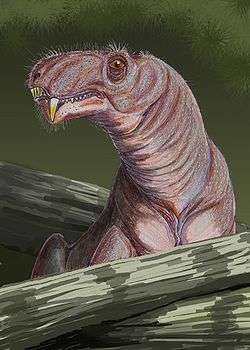Kamagorgon
| Kamagorgon Temporal range: Permian, 270.6–260.4 Ma | |
|---|---|
 | |
| Life restoration of Kamagorgon ulanovi | |
| Scientific classification | |
| Kingdom: | Animalia |
| Phylum: | Chordata |
| Clade: | Synapsida |
| Order: | Therapsida |
| Suborder: | †Gorgonopsia (?) |
| Genus: | †Kamagorgon Tatarinov, 1998 |
| Type species | |
| †Kamagorgon ulanovi Tatarinov, 1998 | |
Kamagorgon is an extinct genus of therapsid from the Middle Permian of Russia. The type and only species is Kamagorgon ulanovi. It is only known from an incomplete skull. The snout is short and the canine teeth are very large. Kamagorgon was named in 1998 and originally classified in the biarmosuchian family Eotitanosuchidae along with the poorly known therapsid Eotitanosuchus.[1] More recently, Kamagorgon has considered as a primitive gorgonopsian rather than a biarmosuchian due to the length of the front jawbone and rear side of the skull. These features are commonly shared by the brithopodid and biarmosuchid lineages.[2]
References
- ↑ Tatarinov, L.P. (1998). "A new eotitanosuchid (Reptilia, Therapsida) from the Kazanian Stage (Upper Permian) of Udmurtia". Paleontological Journal. 33 (6): 660–666.
- ↑ Kemp, T. S. (2006). "The origin and early radiation of the therapsid mammal-like reptiles: A palaeobiological hypothesis". Journal of Evolutionary Biology. 19 (4): 1231–1247. doi:10.1111/j.1420-9101.2005.01076.x. PMID 16780524.
This article is issued from Wikipedia - version of the 9/20/2016. The text is available under the Creative Commons Attribution/Share Alike but additional terms may apply for the media files.
